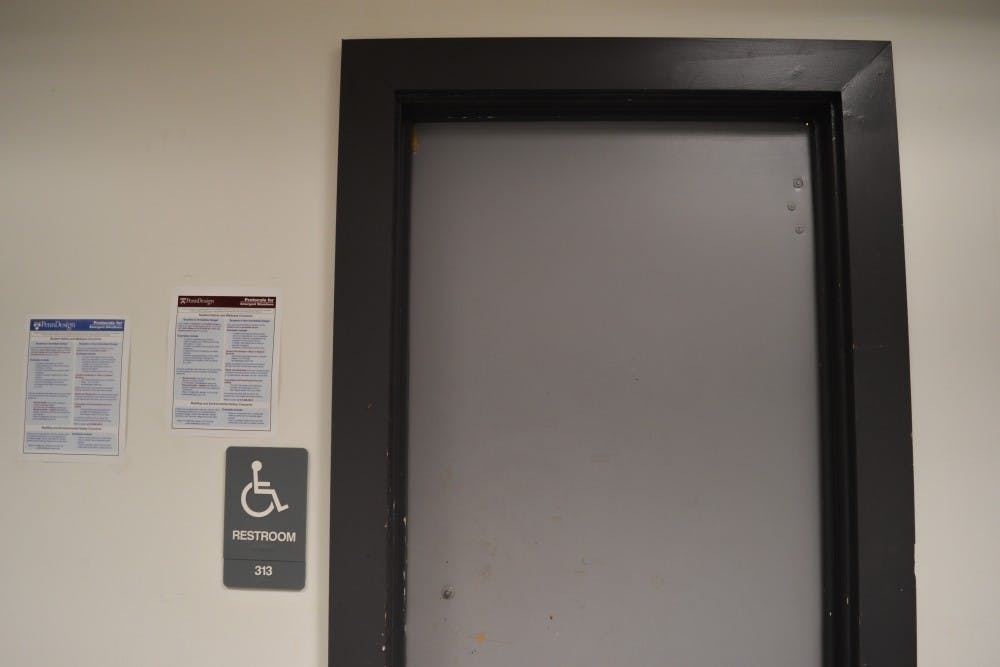
Penn has been working on installing gender-neutral bathrooms in buildings around campus, but since last fall, almost no new bathrooms have been converted to or installed as gender-neutral. Additional steps toward achieving that goal, however, are well underway.
The latest stage in the process, according to University Architect David Hollenberg who is leading the project, has been the creation of a design study.
Last year, Facilities and Real Estate Services, in partnership with LGBT Center Director Erin Cross, determined that over 100 single-stall bathrooms in academic buildings met the criteria set by Cross in order to become gender-neutral bathrooms.
In September, Hollenberg then laid out his goal of converting as many single-stall bathrooms into multi-stall bathrooms in buildings, similar to the layout in Hill College House, which reopened last fall after undergoing an $80 million renovation. Included in the renovation were the first multi-stall gender-neutral bathrooms on campus.
Hollenberg had said he was waiting on buildings to express interest, but that they would be selected to undergo the transition to gender-neutral by early November.
So far, only three academic buildings have expressed interest. Cross, however, said some administrators of other buildings and academic departments also have shown interest in the project.
Hollenberg confirmed that the group has also hired an architect for the study, which will help "identify any code implications, and provide conceptual designs and cost estimates for the rooms in the study." A "kickoff meeting" planned for today hopes to set the project in motion.
Less than 20 percent of non-residential campus buildings, maintained under the FRES, had at least one gender-neutral bathroom accessible to all community members. At the time, some students still expressed frustration over the accessibility and convenience of these bathrooms.
The LGBT Center website keeps track of gender-neutral bathrooms, and how to access them, in various Penn buildings. The list on the LGBT Center website is updated every time a bathroom is added to the roster. The Center also works with RAs and GAs to disseminate the information, especially when first-year students come in.

Along with the University architect, Cross will look at bathrooms in the three academic buildings included in the pilot study – a process she described as “more than just changing a sign on the door.”
The group plans to examine certain aspects of the restrooms to determine whether the bathroom is properly ventilated to accommodate individual “toilet rooms” and what sort of partitions are necessary to include.
The timeline for the construction will vary building to building, but she said she hopes the study will be completed such that the construction can be finalized by this fall for the upcoming academic year.
“It’s going to take a little bit,” Cross said, “but I think with these feasibility studies it's going to show that it's not that hard to convert, even if it’s just getting new partitions that go down lower in some spaces. And that it’s worth it in the long run, by far for everybody involved.”
Chair of the Lambda Alliance and College junior Julia Pan said in speaking with Cross and Associate Director of the LGBT Center Tiffany Thompson about this process, there does not seem to be a firm timeline.
Pan also said she understands why the project has not been widely publicized by Penn. She explained that though the existing gender-neutral bathrooms in academic buildings are open to all, it is important that members of the non-cisgender community are prioritized.
“It’s a difficult balance between keeping the bathroom usage private and also accessible to everyone who actually needs it," she said.
Pan referenced the one gender-neutral bathroom in Huntsman Hall and said for non-binary students in the Wharton School, it is difficult for them to be able to use the sole bathroom, especially when it is accessible to all, including those who are not non-binary individuals.
She highlighted the issue surrounding gender-neutral bathrooms as it affects people’s daily lives in the LGBTQ community.
“If they can’t use a bathroom in Wharton, they literally have to exit the building, go to Stiteler, maybe walk all the way to the LGBT Center, or maybe go back to the high rises where they live,” Pan said. “That just takes so much time out of their day.”
The Daily Pennsylvanian is an independent, student-run newspaper. Please consider making a donation to support the coverage that shapes the University. Your generosity ensures a future of strong journalism at Penn.
Donate




